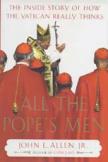Curial Culture
“Those who live for a time in Rome experience the church’s age, but also its youth. They experience the church’s breadth and diversity, its religious and human wealth, but also the limits and weaknesses of its representatives and members.” So writes the widely respected German theologian, the Rev. Hermann Josef Pottmeyer, in his book Towards a Papacy in Communion (Crossroad, 1998). This book by John Allen, Rome correspondent for the National Catholic Reporter since 2000, is a notable confirmation of Pottmeyer’s statement.
It was not always thus with Allen. In his first book, on Cardinal Ratzinger (2000), Allen was out of his depth. Reviewing the book in Commonweal, the Rev. Joseph Komonchak, a professor at Catholic University of America, criticized Allen’s simplistic treatment of a major theologian. In his recent Common Ground Lecture, Allen confessed, with admirable humility, that Komonchak had been right. Allen hoped that in the intervening years he had come to appreciate better the complexity of his subjects.
This book, Allen’s third, shows that his hope was well founded. His aim is “to engage in an act of translation, so that both the Holy See and the American Catholic community can understand what the other party is trying to say.” Allen does this by “identifying the core values and experiences that underlie specific Vatican choices.” He thus does for the Vatican what Luigi Barzini did, brilliantly and most amusingly, for a whole people in his 1964 classic, The Italians (still in print after 40 years).
After an opening chapter on Vatican structures, Allen demolishes five widespread myths about the institution. In reality the Vatican is “a bureaucracy, not an organism.” It reflects, albeit imperfectly, the diversity of the wider Catholic world. Given the distaste of the present pope for administration, no single person is really in charge. As in all bureaucracies, turf wars are frequent. Despite its reputation for secrecy, the Vatican is actually a great deal less secretive than other centers of global power. Its supposed wealth is a myth. The Vatican’s annual budget is substantially less than that of the University of Notre Dame. Its art treasures cost so much to maintain and restore that they amount to a net drain on the Holy See’s budget. Curial careerism, though palpable, is not the rule; and where it exists it is less overt than in secular bureaucracies.
Allen’s chapter on Vatican psychology describes the dominant values of those who run the place. Prominent among them is the importance attached to preserving appearances, bella figura. One example: Rome never had any intention of approving the extra-canonical norms on sexual abuse of minors by members of the clergy that were approved in Dallas in June 2002 by American bishops traumatized by six months of unrelenting media and victim attacks. To avoid embarrassing the bishops, however, the Holy See created a mixed Roman-American episcopal commission to bring the norms into some conformity with church law.
This article also appeared in print, under the headline “Curial Culture,” in the October 11, 2004, issue.








